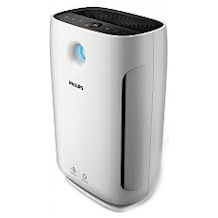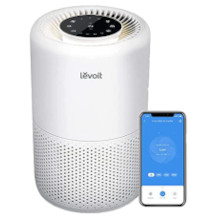Portable air conditioner purchasing advice: how to choose the right product
- What You Need to Know
- Mobile air conditioners do not require the outdoor installation of a second block, instead the exhaust air hose can be hung out of the window.
- Depending on the model, they are suitable for room volumes between 35 and 120 cubic metres.
- Modern units not only cool, but also dehumidify at the same time to prevent excessive humidity and mould growth.
- Additional window sealing is necessary, otherwise the efficiency of the units is considerably reduced.
Mobile air-conditioning units help where the fan fails
Summers are getting hotter and longer in Germany, too. Indoors, especially in the attic, the summer temperatures sometimes become a burden for the occupants. Unlike fans, which only circulate the air but do not cool it, mobile air-conditioning units force a drop in room temperatures. Also called “monoblock”, they are also a counterpart to split units. The latter require installation on the outside wall. Monobloc units, on the other hand, can be used directly in the room with the hose going out.
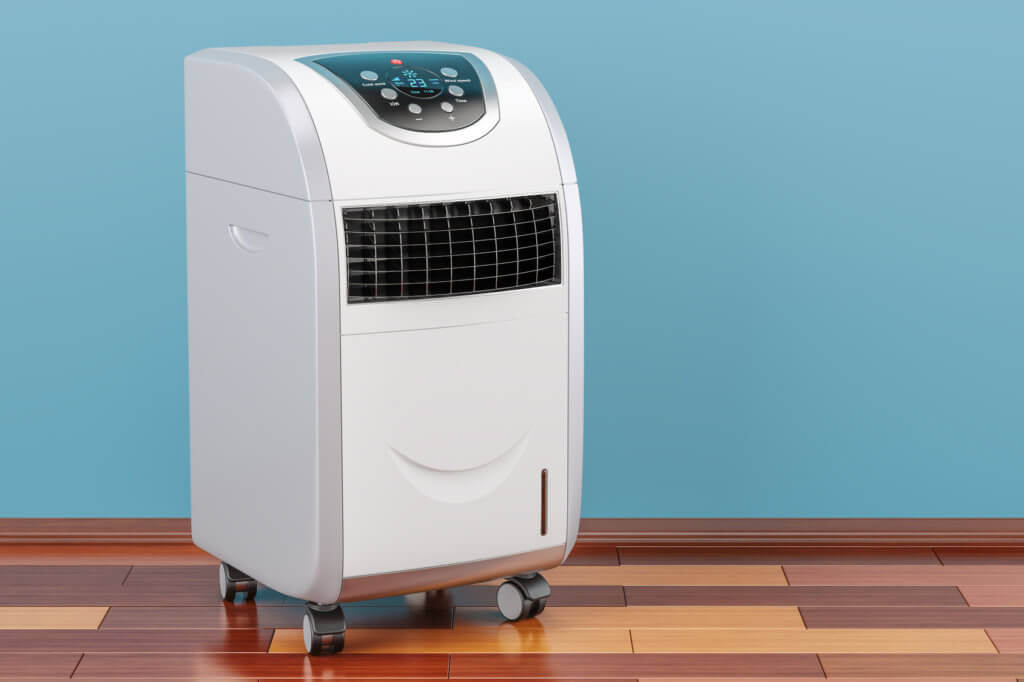
What are mobile air conditioners?
The monobloc air conditioners can best be compared to a freezer in terms of how they work. A coolant is used to significantly reduce the temperature of the discharged air before it is released into the room. However, because the laws of thermophysics do not allow the room temperature to be cooled by this alone, the warm air must be discharged to the outside at the same time.
This already makes it clear how mobile air-conditioning units differ from fans or “air coolers”, for example. All these alternatives do not include the possibility of drawing the warm air out of the room, which is why they only circulate it in the end. The resulting draught is perceived as pleasant, but there is no real cooling. In fact, the room gets even hotter because all these devices are connected to the power supply, which generates additional heat.
Mobile air-conditioning units work just as well with electricity and thus generate heat, but this is dissipated again via the exhaust air hose, while at the same time the cooling capacity exceeds the heat generated. The result: the temperature in the room drops, sometimes by as much as 14 degrees Celsius, depending on the size of the room.
Difference to split air conditioners
Split units are “two-part” air conditioners. In America they have long been standard in many houses and flats, but in Germany they are an absolute rarity. In the “land of tenants”, the biggest hurdle is the conversion they require. Since the second half of the air-conditioning unit hangs on the outside wall, holes have to be drilled. The installation is done on the façade. Tenants who pay for this themselves would either have to dismantle the split air conditioner when they move out or leave it to the next tenant.
The mobile air conditioners do not have this outdoor unit. Instead, they are combined with a loose exhaust hose. It is possible to lead this to the outside via a previously cut and sealed hole in the wall. However, the majority of buyers of mobile air conditioners leave it hanging out of the window. To prevent warm air from entering from the outside, the window is usually sealed with specially designed seals – they work in a similar way to insect screens, i.e. they are stuck directly into or onto the window.
One of the great advantages of mobile air conditioners is the lower initial cost compared to split units. In addition, the mobile models have wheels on the underside. This means that they can be moved back and forth between several rooms as needed to cool them down. When moving out of the flat, the air conditioner and seal are simply taken along. Moreover, since no structural changes are required, tenants do not need to obtain permission from the landlord to use a mobile air conditioner.
How monobloc air conditioners work
The built-in compressor develops a suction effect inside, which attracts and compresses the gaseous refrigerant, causing the temperature to rise. Via the compressor, the gaseous refrigerant is now passed on to the condenser, which brings about a cooling effect. To do this, it makes use of the outside air. At the same time, the state of aggregation of the refrigerant changes from gaseous to liquid. An expansion module in the air conditioner feeds the now liquid refrigerant into the evaporator.
At the same time, a fan draws in the warm room air that is inside. It is passed on to the evaporator, where it cools down and from there is released back into the room. The processes described above with regard to the coolant now come into play: The liquid medium evaporates, to which the warm room air just drawn in contributes. As it evaporates, the cold air is created and released into the room. At the same time, this process ensures that the coolant returns to its original gaseous state and is fed back into the compressor.
This internal circuit is hermetically sealed in the mobile air conditioner. This means that there is no loss of coolant. If the unit has a function for heating rooms, then the circuit just described is reversed for this purpose.
The different types of mobile air conditioners
Although there are many different models of mobile air conditioners, they differ little or not at all in terms of their construction. There is always at least one exhaust air hose to conduct the air to the outside, as well as an integrated refrigerant that contributes to the reduction of the room air.
In the following, we explain the differences between the various types of air conditioners as well as between the basic monobloc models. As expected, the differences between the monobloc systems are rather small – between the air conditioner types they are larger.
Monobloc air conditioners with air/air system
The air/air system is the most widespread alternative. With this variant, the coolant is cooled down via the cooler, previously discharged room air. The mode of operation is therefore the same as described in the previous section. This produces condensation water, which is collected in a container in the unit. You must empty this regularly – usually every two to eight weeks.
Monobloc air conditioners with air/water system
The difference lies in the detail: monobloc air conditioners that work with the air/water system use the condensed water produced during cooling to cool down the refrigerant. This has two advantages: the energy is used more efficiently, and less condensation is produced because it is also used for cooling. However, air/water units are rarer and often have a significantly higher purchase price.
Window air-conditioning units
Another variant would be window air-conditioning units, which are hardly ever used in Germany. They are mainly used in American motels. They have relatively few advantages and are a combination between split and mono units. They are somewhat more efficient than monobloc units, but require structural modifications and direct access to the outside world. In return, no hose is needed.
Advantages and disadvantages of the different types of air conditioners
The different types of air conditioners are each suitable for different circumstances and have different advantages and disadvantages. We provide an overview.
Central building air conditioners
A central air conditioner installed in the building provides effective cooling. Individual flat units or rooms are connected to it via air ducts.
Pro Points
- High energy efficiency
- Adjustability for each individual outlet (air duct)
- Low noise pollution
- Very efficient air exchange
Drawbacks
- Very high initial costs
- Complex structural changes/installation
- Air-conditioning must already be planned for when the building is constructed
- Hardly possible at a later date
Decentralised air conditioning/split systems
This variant only works for one specific room. The second block is located on the outside wall.
Pro Points
- Low noise level, as the noisy block is on the outside wall
- Good permanent solution
- Can be retrofitted
- Cheaper to buy than central air-conditioning units
Drawbacks
- Each room requires its own split unit
- More expensive to run than central air conditioners
- Requires structural alterations and, in the case of tenants, landlord’s consent
- When moving out, the air-conditioning unit usually has to be removed again and structural changes have to be reversed
Mobile air conditioner
The monobloc air-conditioning units described here, which have a single unit indoors and discharge air outside through an exhaust hose.
Pro Points
- Cheapest solution to purchase
- Can be flexibly rolled from room to room
- No structural changes necessary
- uncomplicated solution, simple operation
- Tenants can simply take the air conditioner with them when they move out and continue to use it
Drawbacks
- Worst energy efficiency of all three variants
- Highest noise level, as the noisy components are also indoors
- Changes the appearance of the room because of the thick exhaust hose at the window
- High energy consumption
Buying advice: What really matters when buying mobile air conditioners
A monobloc air conditioner is only as good as it fits the circumstances, requirements and ideas. Therefore, it is important to consider what the unit must have before buying it. The following aspects should be considered.
The room size
The manufacturers of mobile air conditioners usually give a recommendation in cubic metres. The volume of the room is calculated as follows: the area multiplied by the room height.
In addition, there are usually recommendations regarding the maximum room size in square metres. The manufacturers assume that the ceilings are of average height. It is therefore possible to efficiently cool a somewhat larger room or even several adjacent rooms if the ceilings are relatively low, such as in an attic. With particularly high industrial or old building ceilings, on the other hand, only a smaller area can be cooled.
Therefore, pay attention to the manufacturer’s specifications before purchasing. If necessary, you should measure the room area and room height and calculate the volume of the room. If in doubt, a more powerful model is the better choice.
The cooling capacity
The cooling capacity, which is specified in watts, is an essential criterion. How much cooling capacity is needed is determined by the room volume (in cubic metres) and the heat energy. You cannot determine the exact heat energy yourself, but you can use the following list as a guide:
- Factor 15: good insulation, shade, hardly any electrical appliances.
- Factor 20: moderate insulation, occasional sunlight, average number of electrical appliances
- Factor 35: full and prolonged exposure to sunlight, average number of electrical appliances, large windows or penthouse
- Factor 70: no insulation, full sunlight, many electrical appliances
Factor 70 includes, for example, conservatories and computer rooms. Most rooms fall into Factor 20 (storey flat in renovated old building or new building) or Factor 35 (attic flat).
The higher the heat factor, the higher the required cooling capacity. For example, if you want to cool a room volume of 30 cubic metres in the attic, you fall into factor 35. The calculation is then: 30 x 35 = 1050. The cooling capacity must therefore be 1,050 watts.
Energy efficiency
Mobile air conditioners consume a lot of energy. However, good energy efficiency keeps running costs at least within normal limits. Modern units usually have at least energy efficiency class B. Top units are in class A or A+. The highest level (A+++) does not currently exist for mobile air conditioners.
Mobile air conditioners that also heat
Mobile air conditioners that can also heat have an enormously high power consumption. They should therefore only be considered if no classic heating system is actually installed to keep rooms warm in winter.
The volume
The rather high volume of mobile air conditioners is a disadvantage. No monobloc unit runs as quiet as a whisper. “Quiet” units, which are usually labelled “Silent”, produce around 50 to 53 decibels in operation – classic units around 60 to 65 decibels. This corresponds to a conversation at normal volume or a hoover. Anyone considering a mobile air conditioner should therefore be quite insensitive to noise.
It is important to make sure that the devices have sleep/night modes. In this case, they do not cool as much, but they keep the previously reduced temperature constant overnight and are much quieter. If this still bothers you, you should simply cool down rooms beforehand and then switch the unit off.
Hose length
Exhaust air hoses are supplied with the mobile air conditioners. Their length ranges from 0.75 metres to 1.90 metres. If you don’t want to buy a longer hose later, you should also pay attention to this. The hose should not be longer than 1.90 metres anyway, because then too much efficiency would be lost. The following applies: The shorter the hose, the more efficiently the unit works.
The features and functions of mobile air conditioners
The general features just mentioned are the first deciding factor for or against a purchase. It is then worthwhile to familiarise oneself with the individual functions, extras and mechanical condition of the unit. Here, too, there are considerable differences between the manufacturers and their models.
The functions
The basic functions include
- Operation via remote control
- several levels
- an automatic mode
- Sleep mode
- cooling and dehumidification at the same time
- adjustable temperature range (between about 16 and 35 degrees Celsius)
Possible extra features are:
- integration into a smart home network with app control
- Separate function for dehumidification
- Heating function
- Timer with automatic switch-off
- separate fan function
The mechanical properties
Mobile air conditioners are real heavyweights. Even the “light” models weigh at least 22 kilograms, and some even exceed 40 kilograms. Therefore, the units are usually delivered directly to the place of use by a forwarding agent. If you buy such a device in a shop, you have to plan for at least one more person, if not two more helping hands.
In terms of dimensions, there are of course also differences. Usually, the size varies between that of a chair and that of a refrigerator. However, since they are placed in front of the window because of the exhaust air hose, there should be enough space anyway. The workmanship of the mobile air conditioners is of very high quality across the board. This is due to the fact that the manufacturer cannot afford any mistakes, as otherwise the hermetic sealing of the cooling circuit would no longer be guaranteed. Therefore, high-quality materials are used in production and secure seals are made.
Differentiation between entry-level, mid-range and high-end units
Entry-level units cost around 200 to 300 euros – that’s within the season! It is worth bearing in mind that many dealers sharply increase the prices of mobile air conditioners in summer. It is therefore advisable to buy them as a precaution during the cold season, when prices usually reach lows. The entry-level units work with a cooling capacity of 7,000 BTU/h, reach noise levels of 65 decibels at the highest setting and can effectively cool rooms up to 30 square metres. There is no heating function.
Mid-range units work with 9,000 BTU/h cooling capacity and can thus efficiently cool rooms up to 35 square metres. They have a sleep or silent mode and various other settings with which the cooling capacity can be adjusted. There is a remote control and a timer. Larger displays are sometimes installed. The energy efficiency class is “A”. Prices range between 300 and 500 euros.
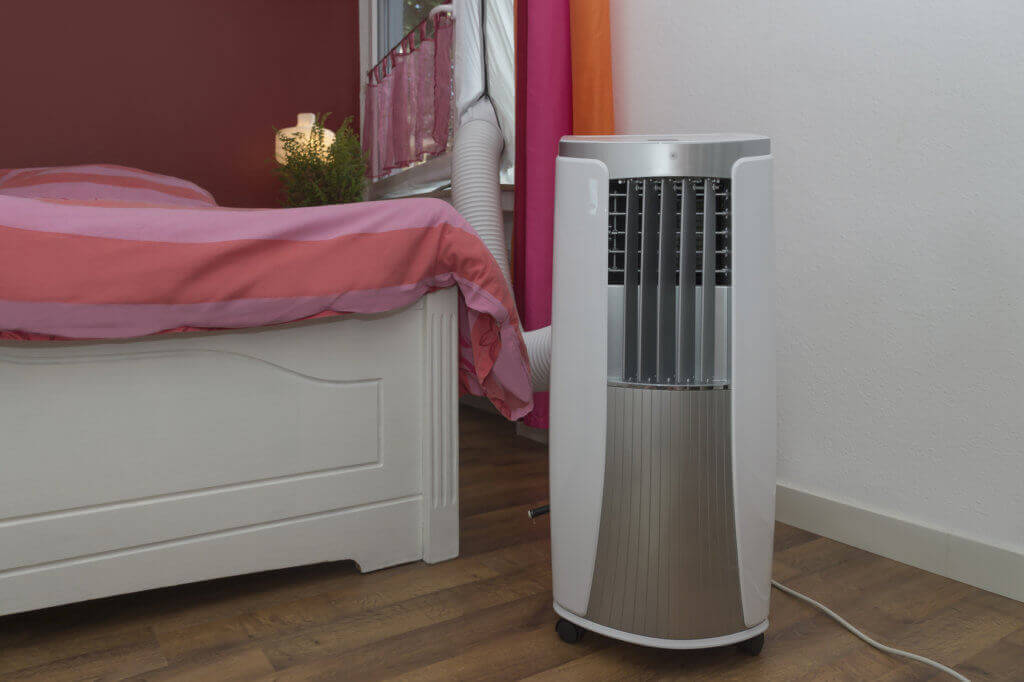
High-end units cost from 700 euros upwards. They are quieter than entry-level and mid-range units, at around 50 to 52 decibels. Their cooling capacity is 11,000 to 12,000 BTU/h; this can cool rooms/apartments up to about 45 square metres. In addition, a more environmentally friendly refrigerant is usually used, but it is more expensive for the manufacturer. Sometimes an air-water system is used, which means that the condensation water does not have to be drained as often and the efficiency is somewhat better. In this case, the units achieve energy efficiency class A+.
Accessories and extras for operating the mobile air conditioners
The exhaust hose is supplied by the manufacturer. If you need a longer hose, you can purchase it separately. Window seals are usually not included, but they are actually absolutely necessary. Without a seal, the warm outside air can still penetrate, which significantly reduces the cooling capacity and efficiency of the mobile air conditioner.
Such seals are also available on the Internet. They are usually insulated seals that are fixed between the window and the window frame. Screws and drilling are not necessary; instead, as with insect nets, adhesive strips are simply used. The seals have zips and can therefore only be opened as far as is necessary for the diameter of the exhaust air hose. If the system is not used, the hose can be pulled out again and the zip closed.
Tip: If it is no longer possible to close the window with the seal, the seals should be attached to the outer frames instead. The manufacturers of these window seals usually show in detail how an optimal seal can be implemented for different types of windows.
Care tips and advice for use
Optimum efficiency is only possible if the unit is used under the best possible conditions. We have already discussed the window sealing that is actually compulsory. At the same time, the unit should not be blocked in any direction by furniture, otherwise cold bridges will form between the furniture and the walls.
The units must also stand on a solid surface. Because of their enormous weight, there is hardly any danger of them tipping over, but care must be taken that they are not placed in the middle of the path where someone could trip over them. Because they are used directly under the window, this is often the case anyway. The accumulated condensation must be emptied regularly. The units emit a signal and refuse to work if too much water has accumulated in the tank – at the latest then emptying is unavoidable.
In addition, the units must be located near a power socket. Because of the high power consumption, no other electronic devices should be connected to this socket, otherwise the fuse could blow more often. The surface should be cleaned with a dry microfibre cloth. In the case of heavy soiling, you can dampen the cloth slightly. Sharp cleaning agents do not belong near a mobile air conditioner, as they could penetrate the cooling circuit.
The built-in filter, usually at the back, should be cleaned every fortnight – as should the filter on the hose and the hose itself. Larger pollen does not usually get in there, but dust and microparticles do. These cleanings should also only be carried out with lukewarm water, as chemical cleaning agents can change the nature of the material and slowly break it down. Before filters and the like are reinserted, they must be absolutely dry.
Units with a dehumidification function (without simultaneous cooling) must not be left unattended during dehumidification. Here, a hose is plugged in, which flows into a bucket or pot. The unit continuously drains water, which is why flooding is possible if it is left unattended. This is not the case with an automatic mode with cooling and dehumidification; the discharged moisture is led directly outside and into the tank.
Caution: Everything that is screwed inside the unit must not be opened by non-professionals! The screw connections protect the cooling circuit and compressor. If non-professionals touch them, they can damage the unit. The top manufacturers offer so-called “on-site maintenance” for their units: an expert from the company or from certified partners comes by and services the unit properly.
Image 1: © natatravel / stock.adobe.com | Image 2: © Tanja Esser / stock.adobe.com

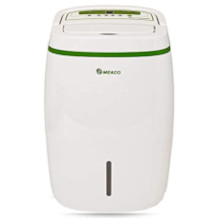
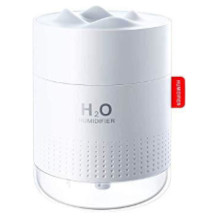
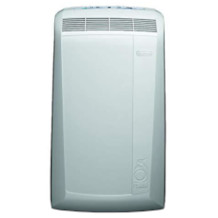
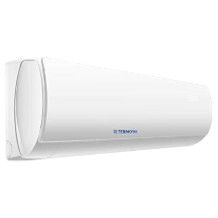
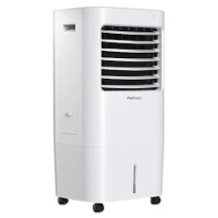
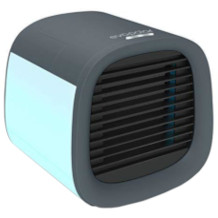
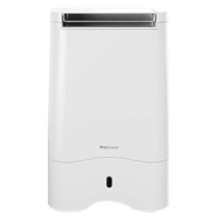
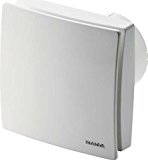
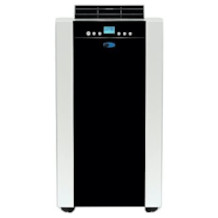
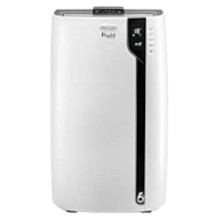

 11,444 reviews
11,444 reviews




